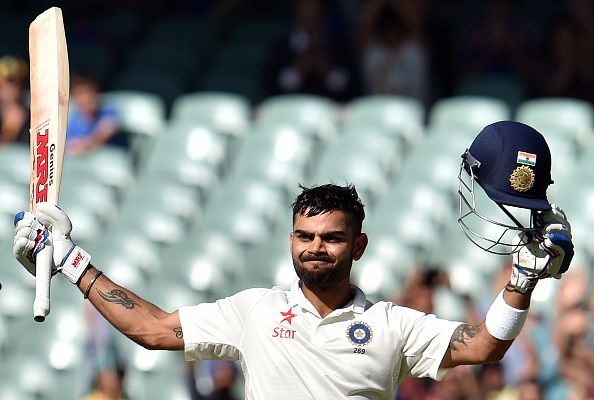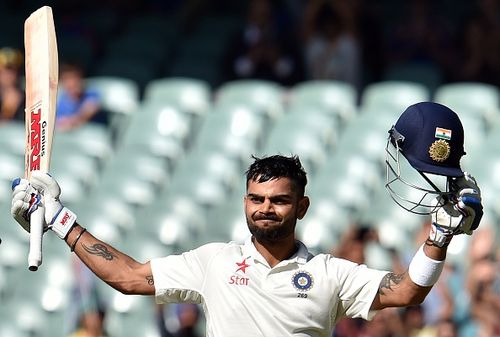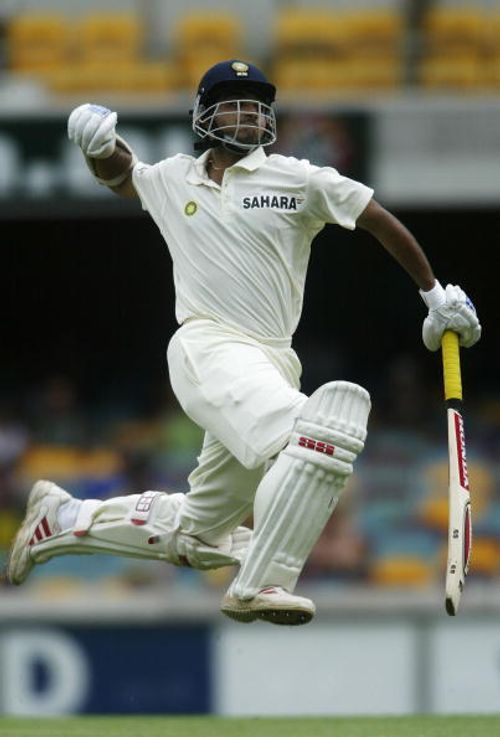
Captain's knock: Virat Kohli brings back memories of Sourav Ganguly's heroics at Brisbane

There’s something about a player batting in Australia that makes you want to sit up and take notice. No matter how dead or lively the wicket might be or how quick or slow the outfield is, runs off the blade Down Under add serious credibility to a batsman’s CV.
When Virat Kohli took guard after the fall of Murali Vijay’s wicket at Adelaide on Thursday, little did we know that we were going to witness one of the finest innings by an Indian captain on Australian soil since Sourav Ganguly set the Gabba alight with a stunning 144 11 years ago.
Back then, the Aussies had initiated an intense pre-series campaign targeting Ganguly, a process they called mental disintegration. It was an obvious attempt to unsettle the opposition’s captain even before the series began. There were repeated talks of “chin music” amidst misplaced notions of a fragile Indian line-up.
When Sourav Ganguly made a statement
When Ganguly walked out to bat at 62/3, the fall of wickets column read: Sehwag (62/1), Dravid (62/2), Tendulkar (63/3). Two of India’s finest when it came to fast bowling had been sent back to the pavilion within a span of one run. There was widespread cynicism regarding Ganguly and his team’s ability to play fast bowling.
Much like the murmurs that questioned Kohli’s aura after his failed attempts in England earlier this year, many thought that it was only captaincy that had kept Ganguly in the team. Quite conveniently, the pundits had forgotten Ganguly’s exploits in England and in the West Indies the previous year, just the way people had conveniently forgotten Kohli’s contributions in South Africa and New Zealand last year.
The field that greeted Ganguly was on expected lines. There was a ring of fielders, starting from the first slip to gully, and from point to cover. The God of the offside had to prove his godliness while the Aussies thought that it was a matter of time till a catch came their way.

On the other end was Akash Chopra, whose primary job was to hold up one end. The captain’s wicket was essential and somewhat inevitable.
What followed was a counter-attack that left Australians gasping for breath. After the odd tentative slash at the start, delivery after delivery was pitched outside off, and delivery after delivery was dispatched for four.
Ganguly rocked back and cut them over point when they were quicker, he slashed them over gully, and when fuller, he caressed them through the covers. He was at his vintage best.
The match scenario at Adelaide wasn’t very different when Kohli took guard on Thursday. Yes, the score read 111/2, and yes, there was a settled batsman on the other end. However, the follow-on mark was 206 runs away and a lot of batting needed to be done.
Mitchell Johnson, tormenter-in-chief of the English and the Proteas last summer, had just dismissed Vijay, caught behind. The pitch might not have been as lively as the one Ganguly batted on, but the task at hand was uphill.
Kohli walks the talk
Within moments, a ball came crashing into Kohli’s helmet. As Johnson looked on concerned, and his teammates, still hurting from Phil Hughes’ tragic demise, huddled around Kohli to check on him, the Indian captain took off his helmet, checked its efficacy, curtly nodded and went back to batting.
The Delhi batsman was walking the talk; the Indians weren’t going to chicken out in the line of fire. The third ball after the blow was pitched slightly further outside off and was driven to the cover boundary in a manner that would’ve made Tendulkar proud. Johnson stood and gaped.
On a similar day in Brisbane, in a rain-affected game just like the ongoing Test, Ganguly went about his task of resurrecting the Indian innings with a lot on his mind. The Australian press had come hard at him, and there was a lot spoken about the impending doom that his team faced in Australia. So for Ganguly, it wasn’t just about an individual innings, it was more the intense desire to sending out a message. And that very determination is something that Kohli’s innings today reminded us of.
As many as 42 deliveries were hurled at him, short and short-of-good length, inviting him to hook and pull, testing his capabilities to tackle the bouncer. But Kohli stuck there doggedly, not playing a lofted shot till the very end. The fact that he lasted all but one of those deliveries and scored 33 runs from them reflected his purpose.
While most of the runs were scored from mid-wicket with the help of those trademark flicks, Kohli punished anything that was outside off and in his zone. In fact, if there was anyone singularly responsible for disturbing Johnson’s rhythm, it was Kohli. The captain scored as many as five boundaries off the left-arm pacer’s bowling at a strike-rate of 109, before falling to him during the last moments of the day’s play.
Demoralizing Australia’s best bowlers
Going after Australia’s main bowlers was the hallmark of both Ganguly’s and Kohli’s knocks. Just like Kohli unsettled Johnson, Ganguly had toyed with the duo of Jason Gillespie and Andy Bichel. Gillespie, who was responsible for Tendulkar and Dravid’s wickets, and Bichel, who could be quite a handful in bowler-friendly conditions, were expected to snag the Bengal batsman’s wicket.
In fact, there was a moment just before lunch, when Bichel hit Ganguly’s shoulder and the latter winced. Someone cat-called from the crowd, asking Ganguly to get off the pitch. At the end of Ganguly’s innings, that person was made to eat his words. Off Gillespie and Bichel’s bowling, Ganguly scored 68 runs from 83 balls with 10 boundaries at a strike-rate of above 80. This was on a day when everybody who batted before him struggled.
The world may eulogize these knocks as examples of what a captain’s innings should be like, but their true significance goes beyond the eulogies. There’s no denying that the mood before the Australia tour this time around was sombre, and the usual banter surrounding a visiting team was missing. But one shouldn’t forget the harrowing experience that the Indian team has had over the past four years in overseas Tests, more so in Australia and England.
It doesn’t take much time before the tongues start wagging at India’s inadequacies in handling lively conditions, and Kohli’s mixture of doggedness and flair sent out a message laden with intent. Just like Ganguly, who with his 144 erased India’s horror memories of 1999 and laid the foundation for a historic win at Adelaide, Kohli stamped his authority and allowed the fulcrum of India’s batting to ease into the conditions, while the rest batted around him.
When Kohli celebrated his century at Adelaide with a passionate cry of “C’mon!” addressed to the dressing room, it was reminiscent of Ganguly leaping into the air after completing his hundred at the Gabba. Gangulya’s was an innings that set the tone of the series; it was a solid start, and hopefully, Kohli’s innings too will bear similar fruits.
It’s not everyday that an Australian team applauds the opposition captain off the field. It happened with Ganguly, and today, a decade later, it was Kohli’s turn to experience the same.